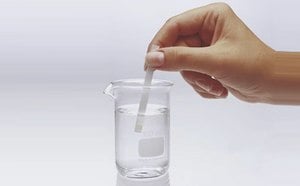Drinking Water Testing

Clean water is essential for drinking, as well as for use in food and beverage production. Only 3% of water in the world is fresh, but fresh water sources can contain chemical contaminants, like perfluorooctanoic acid (PFAS) and arsenic, as well as microbiological contaminants, and pathogens. Even after the treatment process, residual chemicals and contaminants in drinking water can exceed safe and legal levels. Municipalities, private water treatment stations, and food and beverage production facilities must regularly test their water supply to ensure chemical and microbiological contaminant levels are kept at or below compliance levels set by regulatory agencies. With a growing global population, the demand for fresh water is predicted to increase by 40% by 20301, With increased demand, maintaining efficiency and accuracy in water testing will provide a constant challenge.
Featured Categories
Certified Reference Materials: CRMs for forensic, clinical, environmental, pharmaceutical, and food & beverage testing.
Explore Spectroquant® solutions: instruments, software, test kits, accessories. From start to finish, ensure rapid, accurate results with user-friendly handling.
Explore our selection of high-quality analytical reagents for wet chemistry, chromatography, spectroscopy, analytical, titration, water quality control, and electrochemistry.
Our selection of MQuant® and Reflectoquant® test strips includes a variety of test strips for fast, precise, and low-cost analysis in the field or on-site.
Chemical analysis in drinking water testing
Any industry that produces, uses, or processes drinking water must comply with national regulations and perform regular tests to ensure that drinking water is free of chemical and microbiological contaminations. Common chemical contaminants include aluminum, ammonium, bromate, iron, manganese, chloride, nitrate, nitrite, sulfate, chromium, and other metals.
Additional testing is performed when certain industrial environmental pollutants may be present. Volatile organic compounds (VOCs) are often used during manufacturing, including the production of petroleum products, adhesives, pharmaceuticals, paints, or refrigerants. VOCs are also used as gasoline additives, solvents, hydraulic fluids, and dry cleaning agents. VOC contamination is a human-health concern because many are toxic and are known or suspected human carcinogens.
Microbiological analysis in drinking water testing
Fresh water supplies can also be a source of pathogens, leading to the spread and transmission of diseases without microbiological control. Testing the water supply for every pathogens is expensive and time consuming, so indicator organisms are used as assays to detect fecal and other contaminations. Coliforms, Escherichia coli, and Klebsiella pneumoniae are typically used for testing for fecal contamination.
Microbiological testing of commercial beverages and water products is essential to ensure that they are safe to drink, but also to prevent spoilage. Bacteria, yeasts, molds, and pathogens that occur in raw materials or during the production process can decrease the quality and safety of finished products. Both municipal and commercial water supplies are frequently tested to meet regulatory requirements.
Residual disinfectant testing in drinking water
Disinfection of drinking water reduces the risk of pathogenic infections, but the process can leave behind residues and disinfection byproducts (DBPs) that can pose risk to human health. Additionally, organic and inorganic pollutants may be naturally present in our water supply at its source. The identification of pollutants and DBPs is essential to ensure safe consumption.
Drinking water testing methods
Since contaminated water is harmful to humans and the environment, regulatory agencies, like the U.S. Environmental Protection Agency (USEPA), require the use of official standardized methods (e.g., ISO, EPA, AOAC) for testing drinking water and wastewater. These techniques include quantitative testing, chromatography, spectrophotometry, reflectometry, physical parameter measurements (e.g., cloud point, color, hardness, pH, odor), and pathogen testing (molecular or cell culture-based). These quality control tests are done both at the input source, after in-process filtration steps like flocculation and clarification, and also at post-filtration outputs, including tap sampling.
Visit our document search for data sheets, certificates and technical documentation.
Related Articles
- Spectroquant® Iron Test - a suitable alternative to ICP or AAS for determination of iron in drinking water, mineral water, groundwater, and spring water.
- Nonylphenols (NP) are ubiquitous substances that have been detected in highly diverse foodstuff. As breakdown products of nonylphenol ethoxylates, NP could end up in the aquatic environment. This article presents a rapid method for NP detection in surface water by planar solid phase extraction – planar yeast estrogen screen (pSPE-pYES).
- The Safe Drinking Water Act regulates finished drinking water, raw water sources, and distribution to ensure water safety.
- Guideline to calculate your working tolerance - Certified Standard Solutions (CRM)
- See All (3)
Related Protocols
- View instructional videos and download User Manuals for Milli-Q® SQ 2Series lab water systems. You’ll be up and running in no time. Buy online systems, accessories, cartridges and services.
- High performance, reliability, and reproducibility of HS-SPME in combination with GC/MS for the determination of VOCs in water was proven in an interlaboratory trial. The new ISO 17943 using HS-SPME is an improvement on existing official methods for this determination in terms of sensitivity and selectivity.
Find More Articles and Protocols
How Can We Help
In case of any questions, please submit a customer support request
or talk to our customer service team:
Email custserv@sial.com
or call +1 (800) 244-1173
Additional Support
- Chromatogram Search
Use the Chromatogram Search to identify unknown compounds in your sample.
- Calculators & Apps
Web Toolbox - science research tools and resources for analytical chemistry, life science, chemical synthesis and materials science.
- Customer Support Request
Customer support including help with orders, products, accounts, and website technical issues.
- FAQ
Explore our Frequently Asked Questions for answers to commonly asked questions about our products and services.
References
To continue reading please sign in or create an account.
Don't Have An Account?



